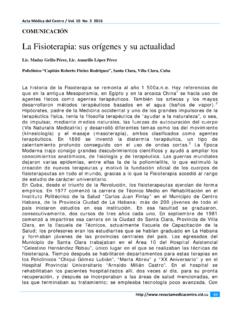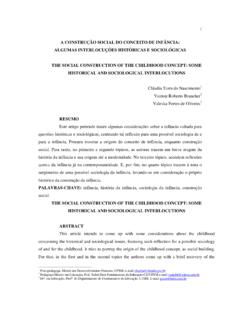Transcription of Perfectionism Is Increasing Over Time
1 Perfectionism Is Increasing Over Time: A Meta-Analysis of Birth CohortDifferences From 1989 to 2016 Thomas CurranUniversity of BathAndrew P. HillYork St John UniversityFrom the 1980s onward, neoliberal governance in the United States, Canada, and the United Kingdomhas emphasized competitive individualism and people have seemingly responded, in kind, by agitatingto perfect themselves and their lifestyles. In this study, the authors examine whether cultural changeshave coincided with an increase in multidimensional Perfectionism in college students over the last 27years. Their analyses are based on 164 samples and 41,641 American, Canadian, and British collegestudents, who completed the Multidimensional Perfectionism Scale (Hewitt & Flett, 1991) between 1989and 2016 ( female,Mage ). Cross-temporal meta-analysis revealed that levels of self-oriented Perfectionism , socially prescribed Perfectionism , and other-oriented Perfectionism have linearlyincreased.
2 These trends remained when controlling for gender and between-country differences inperfectionism scores. Overall, in order of magnitude of the observed increase, the findings indicate thatrecent generations of young people perceive that others are more demanding of them, are moredemanding of others, and are more demanding of :personality, culture, neoliberalism, psychopathologyAcross theindustrialized world, young people now face far toughersocial and economic conditions than their parents (Ipsos MORI,2014). From the late 1970s onward, the United States, Canada, andthe United Kingdom have seen interventionist governance committedto the goals of full employment and social equity replaced by laissez-faire governance committed to the advancement of market-basedcompetition and reward (Piketty, 2014).
3 In addition to changing thebehavior of social and civic institutions, the continuation of thesepolicies has placed a heavier burden on recent generations of youngpeople to strive against one another under the auspices of meritocracyand under the watchful eye of increasingly demanding parents (Col-lishaw, Gardner, Maughan, Scott, & Pickles, 2012; Twenge, 2014;Verhaeghe, 2014). In this study, we are interested in the possibilitythat these cultural changes have coincided with changes in the per-sonalities of young people. Specifically, we examine whether levelsof Perfectionism an achievement and relational personality trait have increased over the past three decades among American, Cana-dian, and British college PerfectionismPerfectionismis broadly defined as a combination of exces-sively high personal standards and overly critical self-evaluations(Frost, Marten, Lahart, & Rosenblate, 1990).
4 It is multidimen-sional and has been examined using different models. Researchershave used both individual models and their constituent subdimen-sions ( , Frost et al., 1990; Hewitt & Flett, 1991; Slaney, Rice,Mobley, Trippi, & Ashby, 2001), as well as combinations ofmultiple models to study Perfectionism ( , Frost, Heimberg,Holt, Mattia, & Neubauer, 1993; Mackinnon & Sherry, 2012; Rice,Ashby, & Slaney, 1998). Studies adopting these approaches haveillustrated the benefits of a multidimensional perspective. Forexample, we now have a better understanding of the many guisesperfectionism can take and the varied outcomes associated with thedifferent Perfectionism dimensions (Stoeber & Otto, 2006).One well-studied model of multidimensional Perfectionism isthat proposed by Hewitt and Flett (1991). In their model, perfec-tionism is understood in terms of the direction of perfectionisticbeliefs and behaviors.
5 When directed toward the self, individualsattach irrational importance to being perfect, hold unrealistic ex-pectations of themselves, and are punitive in their self-evaluations(self-oriented Perfectionism ). When perceived to come from oth-ers, individuals believe their social context is excessively demand-ing, that others judge them harshly, and that they must displayperfection to secure approval (socially prescribed Perfectionism ).When perfectionistic expectations are directed toward others, in-dividuals impose unrealistic standards on those around them andevaluate others critically (other-oriented Perfectionism ). Thismodel was developed at a time when approaches to perfectionismwere unidimensional and focused on only intrapersonal conceptu-alizations of Perfectionism ( , self-oriented Perfectionism ).
6 Inthis regard, the model offered, and continues to offer, an importantadvancement in that both intrapersonal and interpersonal expres-sions of Perfectionism can be studied ( , socially prescribed andother-oriented Perfectionism ).This article was published Online First December 28, Curran, Centre for Motivation and Health Behaviour Change,Department for Health, University of Bath; Andrew P. Hill, School ofSport, York St John concerning this article should be addressed to ThomasCurran, Centre for Motivation and Health Behaviour Change, Departmentfor Health, University of Bath, Claverton Down, Bath BA2 7AY, UnitedKingdom. E-mail: Bulletin 2017 American Psychological Association2019, Vol. 145, No. 4, 410 4290033-2909/19/$ measure self-oriented, socially prescribed, and other-orientedperfectionism, Hewitt and Flett (1991) developed the Multidimen-sional Perfectionism Scale.
7 The validity and reliability of this instru-ment have been established across several decades. The psychometricproperties, including normative data for community and clinical pop-ulations, are provided by Hewitt and Flett (1991, 2004) along withdetailed case studies. The Multidimensional Perfectionism Scale hasbeen used in a wide range of settings in both clinical and nonclinicalsamples. It has also been used extensively in research in collegestudents. Perhaps the main strength of the instrument has been themanner by which the nomological network of the individual dimen-sions has been established through extensive empirical work (seeHewitt, Flett, & Mikail, 2017, for a recent review). This work hasprovided insight into the unique correlates, consequences, and pro-cesses associated with each dimension of show self-oriented Perfectionism to be the most com-plex of the three dimensions of Perfectionism .
8 As self-orientedperfectionism has a salient motivational component (striving toattain perfection and avoid failure), it is often associated withseemingly adaptive achievement-related behaviors (Hewitt &Flett, 1991). However, this achievement behavior belies vulnera-bility to motivational and psychological difficulties that comefrom, among other things, tying one s self-worth to achievementand being unable to derive a lasting sense of satisfaction fromone s accomplishments. Research among college students andyoung people, for example, has found self-oriented perfectionismto be positively associated with clinical depression, anorexia ner-vosa, and early death ( , Enns & Cox, 2005; Fry & Debats,2009; Hewitt & Flett, 1991, 1993). It is also associated with greaterphysiological reactivity ( , elevated blood pressure) and ill-being ( , negative affect) in response to life stress and failure( , Besser, Flett, & Hewitt, 2004; Besser, Flett, Hewitt, & Guez,2008; Hill, Hall, Duda, & Appleton, 2011).
9 The ill-effects ofself-oriented Perfectionism are substantiated in recent comprehen-sive reviews, which found that this dimension of perfectionismpositively correlates with suicide ideation and predicts increases indepression over time an effect typically lost in cross-sectionalstudies (Smith et al., 2016, 2017).Socially prescribed Perfectionism is the most debilitating of thethree dimensions of Perfectionism . This is because the perceivedexpectations of others are experienced as excessive, uncontrolla-ble, and unfair, making failure experiences and negative emotionalstates common (Hewitt & Flett, 1991). The debilitating nature ofsocially prescribed Perfectionism is evident in research on collegestudents, which has found this dimension of Perfectionism to bepositively associated with major psychopathology ( , anxiety,depressive symptoms, and suicide ideation; Martin, Flett, Hewitt,Krames, & Szanto, 1996; Hewitt, Flett, & Weber, 1994; Sherry,Hewitt, Flett, & Harvey, 2003).
10 These relationships have beenreplicated in longitudinal and experimental studies ( , Flett,Endler, Tassone, & Hewitt, 1995; Hewitt, Flett, & Ediger, 1995;O Connor, O Connor, O Connor, Smallwood, & Miles, 2004).Like self-oriented Perfectionism , the reviews of Smith et al. (2016,2017) showed that socially prescribed Perfectionism predictedincreases in depressive symptoms and suicide ideation over time,but to a much greater comparison to self-oriented Perfectionism and socially pre-scribed Perfectionism , other-oriented Perfectionism has received lessattention from researchers. Other-oriented Perfectionism is a distinctdimension of Perfectionism because it manifests in interpersonalbehaviors. As others fall short of the other-oriented perfectionist sexpectations, they are blamed and criticized and generally treated withhostility and disdain (Hewitt et al.)















